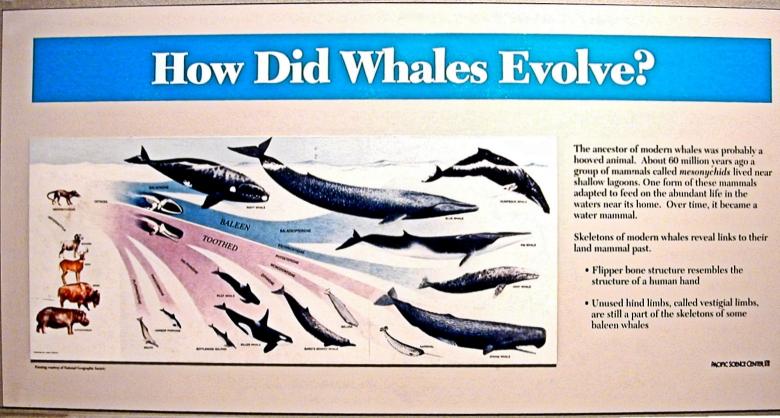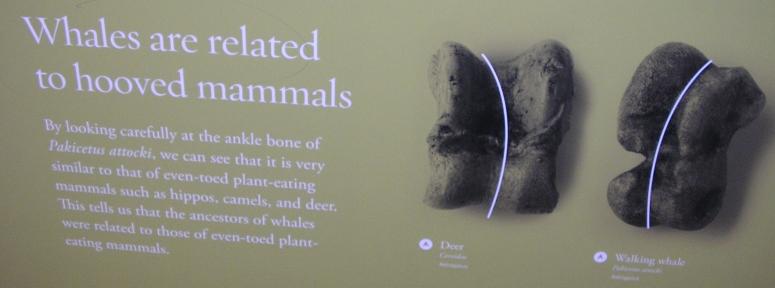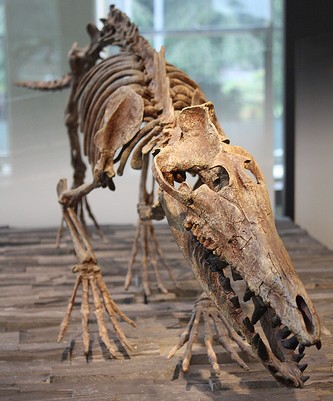
Whales & Fairy Tales
I have been criticized for describing some of the evolutionary explanations of secular scientists as fairy tales. A dictionary definition for a fairy tale is “an unbelievable story, a lie, or a made-up story.” That definition is what I mean by a fairy tale.
The most popular evolutionary story for how whales came about is a case in point. Miscellaneous hoofed animals are thought by evolutionists to be in the line of evolutionary ancestors for the whales as shown in the panel above. On the other hand, biblical creationists know that sea creatures were made by God on Day Five, before land animals were created on Day Six (Genesis 1:20-23). A logical interpretation of that Scripture is land animals did not need to walk back into the sea and become whales, since whales were already made in the beginning by God. Some whales were able to survive the Flood in a similar manner that many other sea creatures did.
Yet today many secular paleontologists tell all who will listen, that land animals did indeed walk back into the sea to become whales. Here follow some quotes to prove to the skeptical that I am not making this up:
- “Somewhere between the mesonychids and the first aquatic whales, there must have been animals which made the transition to aquatic life. Although this seems far-fetched at first, there are actually modern analogues for the process. A coastal fish-eating scavenger could become more and more aquatic as it wades out to catch live, rather than dead fish.”
- “Among mammals which have turned to an aquatic life, the whales constitute the largest and most important group and that best adapted to an existence in the water. Both structurally and functionally they have become completely divorced from their former land life and are helpless if stranded.”
- “Whales are mammals: warm-blooded, air-breathing, and feeding their young with milk. The fossil record shows whales evolved from land-dwelling hoofed mammals related to ancestors of hippos and pigs. After starting to feed part-time in fresh water, their diet changed from plants to aquatic animals. Some species became adapted to life in the oceans, developed the ability to drink salt water and to hear underwater directionally. These spread throughout the world’s oceans and became fully adapted to living and giving birth in water. They eventually reduced their hind legs to small bones.”
From the above quotes, it is clear that secular paleontologists truly say they believe the story that whales evolved from some type of land mammal. ICR creation scientists Morris and Sherwin have written (The Fossil Record, 2010, The Institute for Creation Research, p. 96) that this means evolutionists should be able to credibly answer the following list of questions, if their belief is to be realistically supported by science:
1. Did the land animal’s legs shorten and mutate into flippers?
2. Did the small tail become the fluke, the whale’s broad, powerful swimming tail?
3. Did the nostrils migrate to the top of the skull to become a blowhole?
4. Did the brain case thicken to withstand high water pressure when diving?
5. Did the hide lose its hair and develop a thick layer of blubber for warmth?
6. Did the females acquire ability to give birth and nurse underwater?
7. Did the lungs and other organs adapt to the new environment, or were they replaced by a different design?
8. Did the teeth of some become replaced by baleen and if so, where did the baleen come from?
9. Did these changes happen sequentially and gradually? Or did they happen in one generation?
10. Did the changes occur as mega-mutations?
These questions do more than hint at the believability problems of the ungulate to whale hypothesis. I am not attempting to provide a complete discussion of this topic here. But, consider some of the museum evidence on this topic I have uncovered that follows.
In 2010, the Natural History Museum of Los Angeles County (NHMLAC) opened a brand new display, “The Age of Mammals.” This display is intended to, “explain both the story of mammal evolution – which includes the story of human evolution – and the science behind these specimens, how we know what we know.” As with all other secular natural history museums, the displays in this museum do not “explain how they know what they know,” but rather provide an interpretation of what they might know, if their atheistic presuppositions were true. The story of land animal-to-whale evolution told in the NHMLAC varies from that of other secular paleontologists. Some believe the whale came from one land animal, and others believe the whale came from another. The NMMLAC throws its considerable weight behind Pakicetus attocki as being the “transitional” animal that came from land to the water.
The bones and skull parts of Pakicetus attocki that was discovered in Pakistan and then reconstructed consisted of:
- Over fifty per cent of the skull and much of the skeleton is unknown.
- There are no hooves on the reconstruction.
- The tail bones look like regular land animal tail bones, not parts of a whale fluke.
- The entire reconstruction resembles many other extant land animal skeletons.
- The existing bones look to be part of a completely functioning animal that once lived on land, without any skeletal evidence of impending transitions to aquatic life. A panel at NHMLAC reads, Pakicetus “inner ear bones had some features seen in those of modern whales.” Is this sufficient evidence that Pakicetus is an ancestor of the whale? I think it is more accurate that the statement is an example of how the homology argument matches the faith of the evolutionist that similarity always proves common ancestry. If Pakicetus was a land mammal, as most secular experts now agree, it certainly would not need the same design for its ears as would a whale, but aspects of the ears of mammals are similar throughout anyway. The NHMLA statement that Pakicetus is transitional between land mammals and whales is pure speculation. 

Figure #2 Display Panel at NHMLAC
Look, too, at two final displays from NHMLAC that explain their position on this topic. In Figure #2, the panel states the certainty that, “whales are related to hooved animals.” The displayed evidence intended to prove this statement consists of a deer ankle bone next to a Pakicetus attocki ankle bone. If both of these animals were designed to walk on land it would follow that their ankle bones could be similarly designed and constructed. This is an example of circular reasoning, and in no way proves that whales are related to hoofed animals. And, the current secular reconstruction of Pakicetus attocki on display at NHMLAC, as seen in Figure #3, does not look to have hooves or flippers! If it were to be considered a marine mammal it looks like it would need to dog paddle to get through the water, not the most efficient way to survive extinction if it is on its way to evolving into a whale.
 Figure #3 Skeletal Reconstruction of Pakicetus
Figure #3 Skeletal Reconstruction of Pakicetus - An honest and careful appraisal of the previous discussion must result in an understanding of the tremendous difficulty in reality the ungulate-to-whale hypothesis proposes. How an animal could survive this radical transformation is beyond comprehension. I can only conceive of early extinction for any animal attempting even one of the multitudes of required adaptations proposed. This land animal to whale story definitely requires evolution at its extreme; an unproven process that only exists in the minds of those completely indoctrinated in naturalism.
The story is “made up” by evolutionists as a requirement of their faith that naturalism must have an evolutionary answer for all of the relationships of animals and there is no real fossil evidence that scientifically supports it. The fossil evidence can also be interpreted to match the Bible as well as common sense. Thus the land animal to whale story can rightly be described as a fairy tale.
J.D. Mitchell




